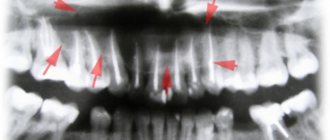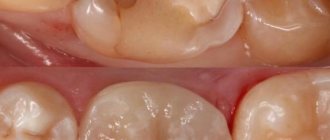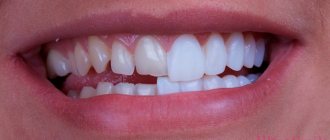Tooth filling is one of the most common and well-established dental procedures, however, it also has its own nuances and subtleties. We tell you what you should pay attention to, what filling to choose and how the filling is installed on a tooth at the ViDentis clinic.
Almost every person has had to deal with a tooth filling in their life. This is a simple and effective procedure, which consists of removing damaged areas of enamel and its further restoration using special compounds. The cost of installing a filling is low, so this treatment is used quite often.
How is dental filling performed?
Installing a filling is a standard procedure that takes place under local anesthesia. First, the person is given an injection in the gum to numb the problem area. After this, doctors proceed to treat the incisor, and the process lasts on average 15-20 minutes.
Main stages:
- The doctor prepares the enamel and drills out the softened dentin using a drill. The patient does not feel pain because he was given an injection.
- The oral cavity is disinfected using an antiseptic solution.
- A special paste with a healing effect is installed, and a gasket is placed for insulation.
- The walls of the oral cavity are dried using air flow.
- The mass is applied layer by layer for further filling.
- The filling is polished to obtain the required occlusion. The crowns should fit tightly.
- Fluoride varnish is applied for protection and distributed over the surface of the filling.
The procedure is simple and standard, so dentists perform it quickly. The patient only needs to listen to the doctor’s advice to avoid problems. If the filling is installed efficiently, it will last for more than one year. The specific period depends on the selected material, quality, and food preferences of the person. Filling is one of the most effective methods of combating caries and pulpitis. Moreover, the procedure is inexpensive and has a minimum number of contraindications.
Filling dental canals
Canal treatment is carried out during deep treatment. The pulp that fills the tooth area is removed, and the walls are cleaned and ground. The process may take a long time, and then the person will have to visit the doctor several times. You will have to install a temporary filling.
The problem area is treated with antibacterial compounds, after which a filling mass is applied. If the procedure is carried out efficiently, then the x-ray will show that the cavity is 100% filled.
The main methods of canal therapy:
- Application of gutta-percha. A standard treatment method that allows you to fill the canals. Hot and cold options are available.
- Depophoresis. The area of the tooth when there are cracks and curvatures is effectively sterilized. The drug is used using a special tool. It can penetrate even into distant areas of the channel.
- Mummification. Impact doses of antiseptic are introduced into the pulp area. The advantage of this option is that the likelihood of inflammation disappears.
- Retrograde filling. A gun with a special attachment is used for it. With its help, you can completely fill the problem cavity.
The dentist will independently choose the appropriate option depending on the situation. The decision is made after an examination, since it is important to determine the condition of the tooth and canal.
What is a tab
Veneers are used to restore the beauty of the front teeth and strengthen them.
Stump tab
used to strengthen molars. More often it is a mini-prosthesis that completely repeats the shape of the internal destroyed part of the crown. It is inserted into the tooth and secured with a special dental compound.
Such structures are a good way to restore a tooth. The inlay is used when the destruction of the natural crown exceeds 30% and there is a healthy root.
Their service life is 20 years or more, the materials tolerate chewing loads and correspond to the anatomical structure of the tooth. Their shade remains unchanged under the influence of food coloring. There are options:
- Restorative
, their role is close to the function of a filling. They are attached to the top of the unit without touching the channels. - Stump mini-prostheses
. Such a frame is fixed in the channel. Then the tooth is covered with a crown. A post-core inlay can help if the visible part of the tooth has crumbled and only the root remains.
Metal-free tab
– restoration of the dental crown, which is orthopedically justified and aesthetically pleasing. The surface wears out synchronously with the enamel, without any discomfort.
Types of fillings
Conventionally, fillings are divided into temporary and permanent. They differ in characteristics and purpose. Temporary ones are placed for therapeutic and diagnostic purposes. Often the composition of the material contains medicinal additives that are necessary for the treatment of a specific disease. The filling will last a short period of time - from 7 days to a month. Much depends on the situation, but in any case you will have to contact a medical specialist again soon.
The integrity of a temporary filling cannot be maintained for more than two weeks. For this reason, you should not put off visiting the dentist until later if you want to avoid problems.
The temporary variety is used in certain situations. A noticeable carious lesion may be observed, but it may not be clear whether only the enamel is affected or whether the lesion has reached the pulp. The doctor will want to examine the incisor in more detail to make an accurate conclusion and perform the correct treatment. The dentist will perform a temporary filling and then monitor the person. If the pain persists, then pulpitis can be suspected. In such a situation, you will have to remove the neurovascular bundle, perform root canal therapy and fill the cavity.
There are several types of permanent fillings. This type is generally intended for long-term and reliable sealing of the treated tooth. It is important to preserve the original characteristics of the incisor, that is, the chewing function should not be impaired. If the tooth is in the anterior region, then it is important to preserve the natural color and shape. In this case, it will not be noticeable that the person did the filling.
Types of fillings depending on the material:
- Cement. It is durable, lasts a long time and meets all requirements. It is important to understand that the density of a cement filling is higher than that of enamel. For this reason, the area that surrounds the filling gradually wears out. As a result, the marginal zone becomes vulnerable, which can lead to secondary caries.
- Amalgam. This variety has many disadvantages. For this reason, this option is extremely rarely used. The composition contains mercury, zinc, copper and silver. The material is durable and does not wear out for a long time. Disadvantages include toxic effects, poor aesthetics and low levels of adhesion.
- Plastic. Now this option is not used, since the material is toxic, has a high probability of deformation, and is easily washed and stained. There is a significant chance of encountering a complication - a secondary form of caries.
- Ceramics. The material is expensive, but of high quality. The filling can last from 20 to 25 years. Ceramics are excellent for filling; their appearance is close to natural teeth. It is durable, resistant to temperature fluctuations, and retains its original shade. Expensive, but the highest quality material.
- Light polymer. The material is considered in demand because it is inexpensive, resembles real teeth in appearance, and has optimal technical performance. The light filling hardens under the influence of an ultraviolet lamp. The dentist may spend a long time shaping the tooth until it achieves the desired appearance. Average service life is 5 years. During this period, the aesthetic appearance is maintained.
- Composite It contains porcelain, which makes the fillings durable and hard. The service life reaches 10-15 years. Among the disadvantages, polymerization shrinkage can be noted. It can be prevented by using additional adhesives that will prevent the occurrence of secondary caries.
It is difficult to say unequivocally which material is best suited in a particular situation. It all depends on the person’s personal wishes, financial capabilities and tooth condition. It is recommended to choose only high-quality materials that will last a long time.
Advantages of direct restoration
In dentistry, as in any branch of medicine, the search for innovative, increasingly effective ways of working that would allow solving any, even the most complex and atypical problems, is of great importance. Direct restorations in modern dentistry, thanks to the use of new highly aesthetic and durable materials, have many advantages. But at the same time they are not without their drawbacks.
Advantages of filling:
- minimal intervention, the ability to keep the tooth alive and extend its service life;
- quick tooth restoration (restoration is carried out directly in the patient’s mouth during one visit to the dentist);
- safety, hypoallergenic, aesthetics, excellent adhesion and strength of modern materials for direct restoration;
- all processes of tooth treatment and restoration are controlled by one specialist, which eliminates errors when transmitting information about the external characteristics of the restoration to the dental technician;
- the ability to choose a shade of material that perfectly matches the color of the patient’s natural teeth;
- The quality of filling does not depend on the presence/absence of the clinic’s own dental laboratory and its equipment.
Even a large filling in a tooth can preserve its vitality, since when filling teeth, the dentogingival attachment, natural contact and exchange of substances between tooth tissues and oral fluid (saliva) are preserved.
Flaws:
- the likelihood of shrinkage of the composite over time;
- less accurate repetition of occlusal surfaces than in the manufacture of crowns;
- the risk of a decrease in the quality of the restoration due to errors/violations of technology - contact of the material with moisture, blood;
- human factor - working with composite materials requires attention, fast and precise actions from the doctor.
Only an experienced doctor can correctly assess the condition of the patient’s tooth and determine the optimal option for its restoration; select the best material. And from the point of view of a specialist, a good restoration is, first of all, a high-quality restoration, performed in compliance with technology and allowing to extend the life cycle of the tooth for many more years.
Filling teeth without pain
Nowadays people do not need to be afraid of visiting the dentist, because dental treatment is carried out without pain. High-quality anesthesia is used, and an allergy test is performed first. If the body accepts the drug normally, then the dose is administered in the gum area. After 1-2 minutes the effect appears. A person may notice that the problem area has lost sensation. After this, the doctor can proceed to the procedure itself.
When using anesthesia, a person will not feel pain. You will be able to relax in the dental chair and not worry about anything. This treatment option is the most preferable, because not every patient wants to endure pain.
Some people decide not to use anesthesia. This is because they do not want to administer the medicine or are suffering from an allergic reaction. If the nerve is not affected, the procedure will cause virtually no pain. An experienced specialist will do everything to make the patient feel as comfortable as possible.
How much should you not eat after filling a tooth?
Filling is considered a simple procedure, after which a person immediately returns to his normal lifestyle. At the same time, dentists warn that it is undesirable to eat and drink drinks right away. It is advisable to abstain from food for 2-3 hours. During this time, the filling will take root, so the food will not be harmful in the future.
It is recommended not to drink coffee or strong tea for 24 hours to avoid staining the material. If the procedure is carried out well, the person will not encounter any problems, and will therefore be able to fully chew with the repaired tooth.
Contraindications
In rare cases, filling leads to complications. A person experiences pain even after 3 days from the date of the intervention. Unpleasant sensations can be sharp and shooting, they cannot be eliminated with the help of analgesics. This happens when there is inflammation of adjacent tissues, incomplete removal of the nerve, or poor material. More often, complications are encountered by those people who did not take into account contraindications. In some cases, the procedure cannot be performed, as it can only worsen the situation.
Main contraindications:
- The tooth cannot be restored, so it will have to be removed.
- An x-ray revealed internal root resorption.
- There is severe resorption, which affects more than a third of the root.
- There are carious perforations in the bottom of the chamber.
- Bone loss in which there is loss of periodontal attachment.
- There is a follicular or odontogenic cyst.
The doctor will tell the person whether there are contraindications for the procedure.
Questions and answers
Should you endure the discomfort from a new filling or go to the doctor?
This question worries patients when they experience pain, a feeling of fullness and an “extra” protruding part of the filling. Complaints can arise for various reasons: displacement of parts (for example, an insulating gasket), shrinkage, formation of an overhanging edge, etc., and there may also be damage to the pulp or insufficient polymerization. If you experience any such sensations, you should contact your dentist.
Maybe it will all go away with time?
You shouldn't hope that everything will go away on its own. If discomfort occurs, you should contact a dental clinic as soon as possible to identify the source of the problem and eliminate it.
What to do if the filling falls out? [2,3]
Loss immediately or some time after installation may be associated with errors in tooth preparation, incorrect selection of filling material and its volume, or violation of individual stages of filling formation. This is a good reason to visit the dentist. It is impossible to keep the tooth cavity open, as this is fraught with food getting inside and the development of inflammation, activation of the carious process, destruction and loss of the tooth.
Can the filling be removed? [2,3]
If the filling shows signs of poor attachment (wobbles, has changed color at the edges, there is a feeling of air or water getting under it), then it is likely that it must be removed. But sometimes such sensations accompany a temporary filling with medicine, and this is not a sign of its failure. To remove it (including if it is no longer aesthetically pleasing), you must consult a doctor.
Medical expert: Oleg Sergeevich Shchekin
Last updated: July 21, 2021
Filling services in our clinic
Our clinic in the center of Moscow offers high-quality dental filling services. Experienced dentists with extensive experience approach each client individually and do everything to ensure that the procedure is comfortable. Doctors will choose the type of filling needed after examining the oral cavity. Only high-quality and modern materials are used, which have a long service life.
We perform root fillings without pain or any discomfort. If necessary, we will restore the primary incisors so that they do not further deteriorate and fall out prematurely.
Dentists guarantee a high-quality result - the filling will not differ in appearance from the tooth. It will last for a maximum period, which is determined by the selected material. There are both budget options and expensive ones. The client will be able to choose a specific filling service based on personal needs.
Which one is better to choose for the smile area?
If you are thinking about which option to choose for dental restoration, the best option in terms of price and quality is a light filling. It has a number of positive aspects:
- There is no need to wait two hours to eat and drink after a dental procedure.
- It is characterized by high strength and a longer service life. On average, a light filling lasts up to 7 years.
- Absolute safety for the body.
- It is possible to choose the color of the seal so that the restored unit does not differ from the rest.










